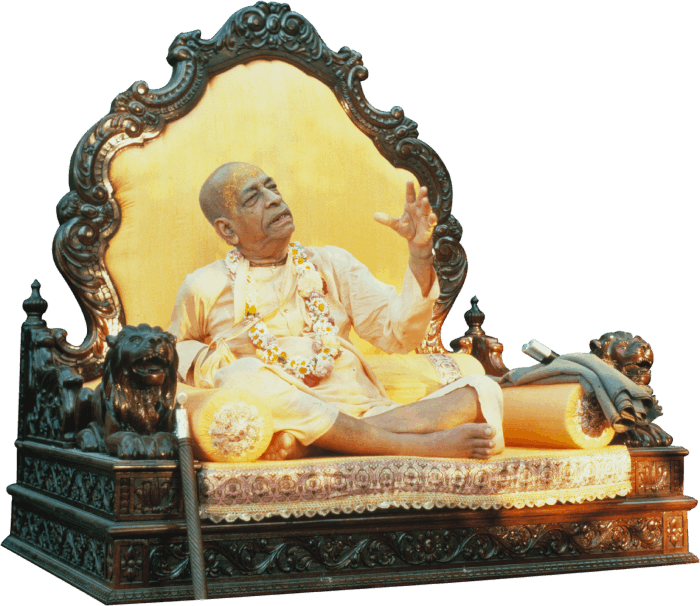
Your ever well-wisher

A.C. Bhaktivedanta Swami

KRISHNAPATH
The Official Source For Srila Prabhupada's Original Books

Your ever well-wisher

A.C. Bhaktivedanta Swami

The Official Source For Srila Prabhupada's Original Books

THOMAS T. KLUGH, youcanreadebooks.com – The western world thinks of yoga as sitting and breathing exercises. While sitting and breathing are part of yoga, they are only two branches of a larger system that makes up yoga. The teaching of yoga comes from India. Patanjali (200 B.C.) put his teachings into sutra form. The yogic system is called Ashtanga Yoga (ashta = eight; anga = limb; yoga = to link to) and it consists of:
1. Yama: things you shouldn’t do
2. Niyama: things you should do
3. Asana: sitting postures
4. Pranayama: breathing exercises
5. Pratyahara: restraining the senses
6. Dharana: concentration
7. Dhyana: meditation
8. Samadhi: trance; to go into
The first four: yama, niyama, asana, and pranayama together are called Hatha yoga. Hatha yoga is how most westerners understand yoga. “Hatha” means “to force”. The idea is that our bodies have become decrepit due to slovenly living and we need to force ourselves back into shape.
The last four: pratyahara, dharana, dhyana and samadhi together are called Raja, or Kingly yoga.
Some students go through the eight limbs one at a time. Most westerners are only interested in sitting and breathing exercises. Ideally, it’s best to have a qualified teacher who can take you through all eight limbs simultaneously. Such a great teacher is His Divine Grace A.C. Bhaktivedanta Swami Prabhupada.
There is also:
1. Karma yoga: linking through fruitive activities; cause and effect
2. Jnana yoga: linking through knowledge
3. Bhakti yoga: linking through devotional service
And if you want to get really picky:
1. Kriya yoga
2. Kundalini yoga
3. Swara yoga
4. Tantra yoga
5. Sahaja yoga
6. Jivanmukti yoga
7. Integral yoga
8. Practically-everything-under-the-sun yoga
There is a tendency to cheapen the yoga teachings by applying variations of yoga to everyday life. So there are teachings like yoga-for-this and yoga-for-that. But real yoga is meant, and has always been intended, for linking with the Supreme Person – Krishna. The best of all the yogic methods listed above is Bhakti Yoga: devotional service. It means to show devotion to another. Devotion can only be shown between two entities. In this case that means you the seeker, and God, and to do so through His pure devotee – a qualified guru in the line of disciplic succession. Bhakti Yoga is the crème of the yoga systems, and I recommend it above all others.
Actually, all of us are already practicing yoga in some form or another. All of us are pursuing some ideal whether it’s our chosen profession, academia, or some domestic endeavor.
If you want to begin thinking about what you should do to practice yoga, you can begin with the first two yogic branches listed above: yama and niyama.
Yama – some things we shouldn’t do
* Being violent
* Lying
* Stealing
* Cheating
* Impatience
* Excessiveness
* Callousness
* Cruelty
* Being too talkative
Niyama – some things we should do
* Love
* Modesty
* Contentedness
* Generosity
* Faithfulness
* Patience
* Austerity
* Read inspirational literature
* Daily recitation of mantras and prayers
* Take instruction from a qualified teacher – preferably a guru
The two lists above are by no means exhaustive. Many of the items have subsections. Some subsections even have subsections. For instance, are we tempted to badmouth someone? Try to resist the urge. Do we like sleeping late? Try to rise early. Do we like to pig out when we eat? Try not to. Do we act differently with the opposite sex when our significant other isn’t around? We should examine ourself. Always be introspective. There are many, many things we can do to improve our yogic practice.
Words of caution and encouragement:
Each person is different from all others and possesses varying degrees of determination. Don’t try to do everything all at once. Nothing is worse than being excited and happy at the beginning of a new endeavor only to realize we’ve taken on a level of practice we can’t handle. Take the first step and practice it slowly but steadily. Then take the second step – then the third and so on. Progress takes time. And most importantly, if we fall down – no matter how many times we fall down – get back up and begin again.

 SAVE QR CODE
SAVE QR CODE